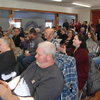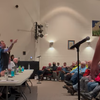Interpreting a town's vision
The Enterprise — Marcello Iaia
Workshop conversation: Councilwoman Amy Pokorny, center, checks on participants at a meeting for the Knox comprehensive plan on July 22. Seated from the left are Tax Collector Diane Champion, and two leaders of the Hilltown Seniors group, Charlotte Fuss and Linda Carman.
KNOX — The questions were big — what are the strengths, weaknesses, opportunities, and threats to living in Knox? — but the crowd was not. In this rural town of 2,700, about 18 men and women sat in small groups to discuss issues that would shape how the Knox comprehensive plan would be modified.
Slips of paper on each table listed answers to a vision survey, and the residents — almost half of them town officials — were tasked with analyzing the responses and suggesting how the town should address them.
“We’re kind of laying the foundation of the process tonight,” Amy Pokorny told the group before they took their seats on July 22. Pokorny, a town councilwoman, is leading the process of gathering public input aimed at developing recommendations for revising the plan. The current plan is almost 20 years old.
The town’s tax collector, Diane Champion, sat at a table dedicated to medical service, elderly issues, convenience, and transportation. Her group agreed medical services were accessible to people in the Hilltowns, like a clinic on Western Avenue in Guilderland, which is not far away, and the conversation quickly focused on the need for more transportation services for elderly people. A van for medical appointments and a bus for shopping trips in Berne are available to Knox residents.
“There’s going to be a point in time when we may not be able to drive — we need that service,” Champion told four others in the group.
As a disadvantage for elderly people in Knox, one response read, simply, “Seniors need services.” Charlotte Fuss, the president of the Hilltown Seniors group, said she’d like to see the same activities in Knox as in Berne — church dinners, a library, a seniors center — even in modest ways.
Another Hilltown Seniors member, Linda Carman, spoke about the financial pressure that some elderly people are under, trying to pay their bills and taxes.
“When they decide to sell their home,” she said, “what price are they going to get for it?” adding that selling can take a long time.
Other survey responses described access to highways as convenient. The group agreed, as it did with a common survey response for Knox’s future favoring its low population density and rural character, or even to be like it was two decades ago.
“Now, everybody’s just so busy trying to make ends meet that we’re losing volunteers,” Champion said of community organizations, like the fire company.
“Resistance to change” was listed as a threat by another group, discussing economics, along with a declining population of young people, a lack of options to transfer farm and forest land. Another threat was ignoring the listed strengths, weaknesses, and opportunities, which included broadening the definition of home occupancy in the zoning law and pursuing grants for business development.
“No consistency in Town government approach to permitting or allowing business,” the group wrote as one of the weaknesses.
The group concluded that threats to agriculture include suburban sprawl, run off, pesticides, taxes, and declining agriculture. The group listed the town’s strengths as open space, individually-owned farms, and rural character. It suggested creating more opportunities and incentives for conservation, and creating more business districts and cluster development.
Gary Kleppel disputed the claim that small-scale agriculture is a “dying business.”
He noted many of the responses favored agriculture, rural character, and business. “There are messages that are just staring at us,” said Kleppel, a sheep farmer and biology professor at the University of Albany.
Farmers’ markets, protecting tillable land, and tax assessments that favor agricultural uses were listed as opportunities. Kleppel asked how realistic markets would be.
“I sell a bread a minute in Delmar,” he said of a farmers’ market there, noting one in Berne had closed for lack of business.
Vasilios Lefkaditis suggested a barn he owns near the intersection of Knox Cave Road and Route 156 is a convenient location for a farmers’ market.
“You’re going to save it then?” Elizabeth Ketcham asked Lefkaditis.
“I’m going to try and save it,” he said.
Another group, discussing aesthetics, education, culture, and social environment, wrote as opportunities: growing involvement in the school and community, and enforcing laws to clean up properties. For threats, it listed taxes, the loss of historic buildings, the isolation affecting business, and development that is counter to the town’s rural character.
At a fourth table, a group wrote that the town’s clean water is a strength, suggesting more hazardous-waste days, sanding roads instead of salting, and creating a central septic system for the Knox hamlet. Land conservation districts, agricultural land, and Thacher Park were all considered strengths of land conservation in the town, but the group also wrote conserving too much land “could lead to restrictive zoning.”
The same group wrote that the town has a good recycling program, but suggested it also create an area to swap or sell items. It listed a lack of information about battery recycling, and listed residents who don’t recycle as a threat.
A group talking about government and town promotion listed these opportunities: expanding information on the town’s website and using free Wi-Fi hotspots, a community swap of unused items, and volunteering. It encouraged focusing growth closer to the hamlet, and involving young people in agriculture.
Among strengths, the group wrote that Knox residents care about the town, it has a “small town” nature; “not a lot of regulation”; and that, as a rural town, it is unlikely to see unwanted development. As weaknesses, the group wrote, “people in Knox don’t like rules,” and that the town has noisy dirt bikes, junk cars, derelict buildings, a need for communication, and a lack of services and social gathering places.
The groups didn’t get to all of their assigned topics before the session ended. They will return to the task another day, Pokorny said. All of the public input, including responses to a longer questionnaire mailed to residents, will need to be reviewed.
Further meetings will define terms, like “natural beauty” and “rural character,” often used to describe the town, and will come up with a vision statement, and confirm or update the town’s goals.
Pokorny said, while the deadline was extended until the end of July, she would still accept survey responses until mid-August.


